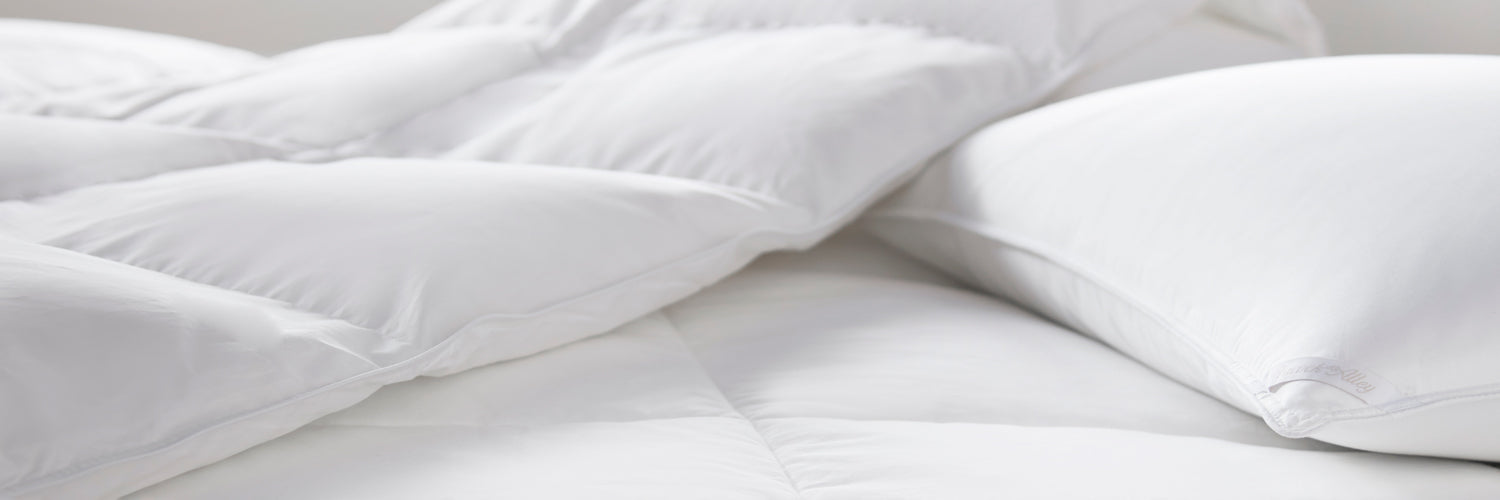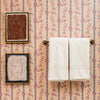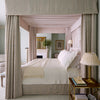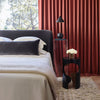A duvet is made from cloth sewn to form a large bag, then filled with goose down or other soft materials. A duvet is used as the top layer of bedding to keep the sleeper warm as they rest. Duvets are also called duvet inserts as they are most commonly inserted into a cover.
At Peacock Alley, we offer luxury duvets, made with down and down alternative. You may be more familiar with comforters and not sure what a duvet is. Did you know duvets also require covers? Below we break down everything you need to know about duvets.
What is a Duvet?
Some use the word duvet interchangeably with comforter as both words are used to refer to the top layer on your bed. In fact, some dictionaries include the word comforter in the entry as a synonym,but these two pieces of bedding are not the same.
--> Shop Top Recommended: The White Goose Down Duvet
The word duvet comes from the French word for down, which is still a very popular filling for duvets. Today, you can find duvets filled with goose down as well as other natural choices, such as wool or feathers. When comparing down vs down alternatives in duvets, Peacock Alley down duvets are made with high-quality European white goose down while our down alternative duvets are made with an equally cozy and responsibly sourced synthetic material with hypoallergenic benefits.
Duvet inserts are typically white, and they are almost always plain, so they won’t show through the duvet cover. Here at Peacock Alley, we are also well known for our luxury duvet covers.

Duvets vs Comforters
While duvets and comforters are similar, here are the important factors to consider.
1. Comfort
Duvets tend to be fluffier and warmer compared to comforters thanks to their high quality down or down alternative fill. Comforters tend to be much flatter with lower quality insulation and may require an additional blanket during colder months.
2. Weight
Duvets are typically made in specific weights for different levels of warmth, whereas comforters are made with design aesthetics in mind. Most comforters are not filled with high quality down and may vary in weight (and warmth) depending on the chosen fill.
3. Maintenance
Duvet inserts do not need to be washed often as their cover. This makes routinely washing your bedding much easier. Comforters must be washed more often, as they don’t have a cover, and can wear easily when washed. Having a duvet cover greatly simplifies washing and caring for your bedding.
4. Style
Some choose comforters over duvets because they might match their current design aesthetic. However, comforters don’t have an outer cover to easily change, which leaves you stuck with the design of the comforter you’ve chosen. Duvets are far superior in style and function as they are traditionally white and require a cover. Duvet covers can be updated seasonally or as often as you’d like giving you the perfect way to switch up the style of your bedding.
5. Cost
Duvets tend to be more expensive than comforters as they are often made with higher quality materials and last much longer. Duvets serve as a very long-term bedding option, while new comforters are purchased when you’d like to transition to a different style or when your comforter has worn out too much in the wash.
What is a Duvet Cover?
A duvet cover is a protective sleeve that covers your duvet, much like a pillowcase on your pillow. In addition to protecting the duvet, it allows you to easily change the look of your bedding, without having to replace the entire duvet. Duvet covers are easily cleaned, and compact for storage.
Some skip the top sheet when making a bed with a duvet, because the duvet cover acts much the same way as a sheet. This is common practice in Europe, where duvets are heavily favored. If you’ve heard someone describe their sleep temperature or style as sleeping European, this is what they mean!

The Difference Between Duvets and Comforters
Duvets are warm, surprisingly lightweight, easy to maintain and very versatile. The duvet cover makes it easier to change bedding styles by keeping the same duvet insert and updating your cover. You won’t need to wash your duvet insert very often, just wash the cover regularly.
Comforters tend to be flatter, may feel heavy depending on the fill, and are not usually as warm as duvets. They also require extra care when compared to a duvet and are more likely to wear with washing over time. When dressing your bed with a comforter, you’ll have to switch out the entire comforter if you want to change up your look as they are made with decorative fabrics and no additional cover. A comforter is a simple, one-and-done option for those who don’t want a separate covering.
So which is better in the duvet vs. comforter debate? Like most bedding choices, it is 100% personal preference. We prefer duvets for their ease of care and ability to change styles, but many like the simplicity of a comforter.
Our advice: Choose the bedding that works best for your home and lifestyle, and you can’t go wrong.
A duvet is made from cloth sewn to form a large bag, then filled with goose down or other soft materials. A duvet is used as the top layer of bedding to keep the sleeper warm as they rest. Duvets are also called duvet inserts as they are most commonly inserted into a cover.
At Peacock Alley, we offer luxury duvets, made with down and down alternative. You may be more familiar with comforters and not sure what a duvet is. Did you know duvets also require covers? Below we break down everything you need to know about duvets.
What is a Duvet?
Some use the word duvet interchangeably with comforter as both words are used to refer to the top layer on your bed. In fact, some dictionaries include the word comforter in the entry as a synonym,but these two pieces of bedding are not the same.
--> Shop Top Recommended: The White Goose Down Duvet
The word duvet comes from the French word for down, which is still a very popular filling for duvets. Today, you can find duvets filled with goose down as well as other natural choices, such as wool or feathers. When comparing down vs down alternatives in duvets, Peacock Alley down duvets are made with high-quality European white goose down while our down alternative duvets are made with an equally cozy and responsibly sourced synthetic material with hypoallergenic benefits.
Duvet inserts are typically white, and they are almost always plain, so they won’t show through the duvet cover. Here at Peacock Alley, we are also well known for our luxury duvet covers.

Duvets vs Comforters
While duvets and comforters are similar, here are the important factors to consider.
1. Comfort
Duvets tend to be fluffier and warmer compared to comforters thanks to their high quality down or down alternative fill. Comforters tend to be much flatter with lower quality insulation and may require an additional blanket during colder months.
2. Weight
Duvets are typically made in specific weights for different levels of warmth, whereas comforters are made with design aesthetics in mind. Most comforters are not filled with high quality down and may vary in weight (and warmth) depending on the chosen fill.
3. Maintenance
Duvet inserts do not need to be washed often as their cover. This makes routinely washing your bedding much easier. Comforters must be washed more often, as they don’t have a cover, and can wear easily when washed. Having a duvet cover greatly simplifies washing and caring for your bedding.
4. Style
Some choose comforters over duvets because they might match their current design aesthetic. However, comforters don’t have an outer cover to easily change, which leaves you stuck with the design of the comforter you’ve chosen. Duvets are far superior in style and function as they are traditionally white and require a cover. Duvet covers can be updated seasonally or as often as you’d like giving you the perfect way to switch up the style of your bedding.
5. Cost
Duvets tend to be more expensive than comforters as they are often made with higher quality materials and last much longer. Duvets serve as a very long-term bedding option, while new comforters are purchased when you’d like to transition to a different style or when your comforter has worn out too much in the wash.
What is a Duvet Cover?
A duvet cover is a protective sleeve that covers your duvet, much like a pillowcase on your pillow. In addition to protecting the duvet, it allows you to easily change the look of your bedding, without having to replace the entire duvet. Duvet covers are easily cleaned, and compact for storage.
Some skip the top sheet when making a bed with a duvet, because the duvet cover acts much the same way as a sheet. This is common practice in Europe, where duvets are heavily favored. If you’ve heard someone describe their sleep temperature or style as sleeping European, this is what they mean!

The Difference Between Duvets and Comforters
Duvets are warm, surprisingly lightweight, easy to maintain and very versatile. The duvet cover makes it easier to change bedding styles by keeping the same duvet insert and updating your cover. You won’t need to wash your duvet insert very often, just wash the cover regularly.
Comforters tend to be flatter, may feel heavy depending on the fill, and are not usually as warm as duvets. They also require extra care when compared to a duvet and are more likely to wear with washing over time. When dressing your bed with a comforter, you’ll have to switch out the entire comforter if you want to change up your look as they are made with decorative fabrics and no additional cover. A comforter is a simple, one-and-done option for those who don’t want a separate covering.
So which is better in the duvet vs. comforter debate? Like most bedding choices, it is 100% personal preference. We prefer duvets for their ease of care and ability to change styles, but many like the simplicity of a comforter.
Our advice: Choose the bedding that works best for your home and lifestyle, and you can’t go wrong.
Shop Duvet Inserts
A duvet is made from cloth sewn to form a large bag, then filled with goose down or other soft materials. A duvet is used as the top layer of bedding to keep the sleeper warm as they rest. Duvets are also called duvet inserts as they are most commonly inserted into a cover.
At Peacock Alley, we offer luxury duvets, made with down and down alternative. You may be more familiar with comforters and not sure what a duvet is. Did you know duvets also require covers? Below we break down everything you need to know about duvets.
What is a Duvet?
Some use the word duvet interchangeably with comforter as both words are used to refer to the top layer on your bed. In fact, some dictionaries include the word comforter in the entry as a synonym,but these two pieces of bedding are not the same.
--> Shop Top Recommended: The White Goose Down Duvet
The word duvet comes from the French word for down, which is still a very popular filling for duvets. Today, you can find duvets filled with goose down as well as other natural choices, such as wool or feathers. When comparing down vs down alternatives in duvets, Peacock Alley down duvets are made with high-quality European white goose down while our down alternative duvets are made with an equally cozy and responsibly sourced synthetic material with hypoallergenic benefits.
Duvet inserts are typically white, and they are almost always plain, so they won’t show through the duvet cover. Here at Peacock Alley, we are also well known for our luxury duvet covers.

Duvets vs Comforters
While duvets and comforters are similar, here are the important factors to consider.
1. Comfort
Duvets tend to be fluffier and warmer compared to comforters thanks to their high quality down or down alternative fill. Comforters tend to be much flatter with lower quality insulation and may require an additional blanket during colder months.
2. Weight
Duvets are typically made in specific weights for different levels of warmth, whereas comforters are made with design aesthetics in mind. Most comforters are not filled with high quality down and may vary in weight (and warmth) depending on the chosen fill.
3. Maintenance
Duvet inserts do not need to be washed often as their cover. This makes routinely washing your bedding much easier. Comforters must be washed more often, as they don’t have a cover, and can wear easily when washed. Having a duvet cover greatly simplifies washing and caring for your bedding.
4. Style
Some choose comforters over duvets because they might match their current design aesthetic. However, comforters don’t have an outer cover to easily change, which leaves you stuck with the design of the comforter you’ve chosen. Duvets are far superior in style and function as they are traditionally white and require a cover. Duvet covers can be updated seasonally or as often as you’d like giving you the perfect way to switch up the style of your bedding.
5. Cost
Duvets tend to be more expensive than comforters as they are often made with higher quality materials and last much longer. Duvets serve as a very long-term bedding option, while new comforters are purchased when you’d like to transition to a different style or when your comforter has worn out too much in the wash.
What is a Duvet Cover?
A duvet cover is a protective sleeve that covers your duvet, much like a pillowcase on your pillow. In addition to protecting the duvet, it allows you to easily change the look of your bedding, without having to replace the entire duvet. Duvet covers are easily cleaned, and compact for storage.
Some skip the top sheet when making a bed with a duvet, because the duvet cover acts much the same way as a sheet. This is common practice in Europe, where duvets are heavily favored. If you’ve heard someone describe their sleep temperature or style as sleeping European, this is what they mean!

The Difference Between Duvets and Comforters
Duvets are warm, surprisingly lightweight, easy to maintain and very versatile. The duvet cover makes it easier to change bedding styles by keeping the same duvet insert and updating your cover. You won’t need to wash your duvet insert very often, just wash the cover regularly.
Comforters tend to be flatter, may feel heavy depending on the fill, and are not usually as warm as duvets. They also require extra care when compared to a duvet and are more likely to wear with washing over time. When dressing your bed with a comforter, you’ll have to switch out the entire comforter if you want to change up your look as they are made with decorative fabrics and no additional cover. A comforter is a simple, one-and-done option for those who don’t want a separate covering.
So which is better in the duvet vs. comforter debate? Like most bedding choices, it is 100% personal preference. We prefer duvets for their ease of care and ability to change styles, but many like the simplicity of a comforter.
Our advice: Choose the bedding that works best for your home and lifestyle, and you can’t go wrong.





























